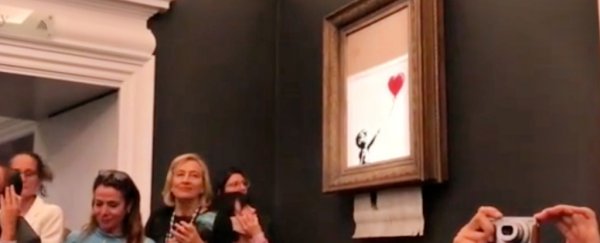Anonymous British graffiti artist Banksy has pulled off another stunt that seized the attention of the art world — this time at the expense of his own work.
On Friday, a Banksy painting titled "Girl with Red Balloon" was being auctioned at Sotheby's in London. The spray-painted and acrylic piece depicted a little girl extending her arm out for a heart-shaped balloon, floating far beyond reach.
The bidding climbed to US$1.4 million, an amount that tied the artist's own auction record from 2008. Finally, a hammer pounded to signify the end of the auction.
Right then, the painting's canvas began scrolling downward, seeming to pass through its elaborate gilded frame — and reappearing below in neat, vertical strips. Later, Sotheby's would explain that a shredder was hidden inside the frame.
The crowd began murmuring as they realized what was happening: The painting was "self-destructing" before their very eyes.
"It appears we just got Banksy-ed," Sotheby's senior director Alex Branczik said in a statement that described the incident as "the first time in auction history that a work of art automatically shredded itself after coming under the hammer." (As the saying goes: Fool me once …)
The incident spurred questions about how Banksy had pulled it off and whether he had been at the auction in disguise. Branczik told the Art Newspaper on Friday that he was "not in on the ruse."
"We are busy figuring out what this means in an auction context," Branczik told the outlet.
"The shredding is now part of the integral art work. We have not experienced a situation where a painting has spontaneously shredded, upon achieving a record for the artist."
Sotheby's did not publicize who purchased the piece. Representatives for the auction house did not immediately respond to questions Saturday.
Banksy on Saturday posted a video to Instagram that showed footage of a shredding mechanism being built into a frame for, presumably, "Girl with Red Balloon."
"A few years ago I secretly built a shredder into a painting," he stated in the video text, "in case it was ever put up for auction …"
The video then jumped to clips of Friday's auction at Sotheby's, indicating that Banksy — or someone who works with him — was there when it happened.
"The urge to destroy is also a creative urge," Banksy captioned the Instagram post.
Banksy has managed to keep his real identity secret from the public for decades — often spray-painting his murals under cover of night — while building a reputation for provocative street art with subversive, anti-establishment messaging.
In 2007, he painted the words "ONE NATION UNDER CCTV" on the side of a British postal service building.
Another of his murals, 2012′s "Slave Labour," showed a young boy sewing Union Jack bunting, probably a jab at the then-upcoming celebrations for Queen Elizabeth II's diamond jubilee. (The nonprofit group Art Story maintains a good list of Banksy's most notable pieces.)
The artist has famously criticized commercialism, once selling his canvasses through a Central Park pop-up shop for $60 apiece to unsuspecting customers, according to Forbes.
"Graffiti art has a hard enough life as it is, before you add hedge-fund managers wanting to chop it out and hang it over the fireplace," the New York Times quoted Banksy as saying in 2013.
"For the sake of keeping all street art where it belongs, I'd encourage people not to buy anything by anybody, unless it was created for sale in the first place."
The irony, though, is that "Girl with Red Balloon" may have increased in value after its self-destruction, shredded pieces and all. Joey Syer, the co-founder of MyArtBroker.com, told the Evening Standard that the painting could have added 50 percent to its value.
"The auction result will only propel this further, and given the media attention this stunt has received, the lucky buyer would see a great return on the [$1.4 million] they paid last night," Syer told the newspaper. "This is now part of art history in its shredded state."
2018 © The Washington Post
This article was originally published by The Washington Post.
